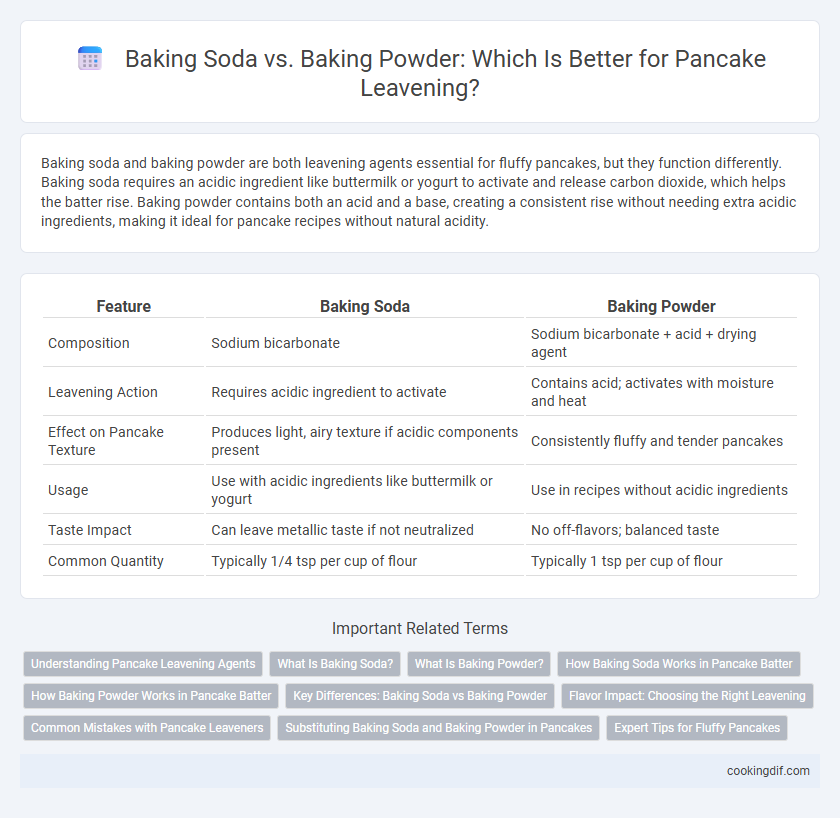Baking soda and baking powder are both leavening agents essential for fluffy pancakes, but they function differently. Baking soda requires an acidic ingredient like buttermilk or yogurt to activate and release carbon dioxide, which helps the batter rise. Baking powder contains both an acid and a base, creating a consistent rise without needing extra acidic ingredients, making it ideal for pancake recipes without natural acidity.
Table of Comparison
| Feature | Baking Soda | Baking Powder |
|---|---|---|
| Composition | Sodium bicarbonate | Sodium bicarbonate + acid + drying agent |
| Leavening Action | Requires acidic ingredient to activate | Contains acid; activates with moisture and heat |
| Effect on Pancake Texture | Produces light, airy texture if acidic components present | Consistently fluffy and tender pancakes |
| Usage | Use with acidic ingredients like buttermilk or yogurt | Use in recipes without acidic ingredients |
| Taste Impact | Can leave metallic taste if not neutralized | No off-flavors; balanced taste |
| Common Quantity | Typically 1/4 tsp per cup of flour | Typically 1 tsp per cup of flour |
Understanding Pancake Leavening Agents
Baking soda and baking powder are essential leavening agents that influence pancake texture and rise through different chemical processes. Baking soda requires an acidic ingredient like buttermilk to activate and produce carbon dioxide gas, causing pancakes to rise quickly and become tender. Baking powder contains both an acid and a base, releasing carbon dioxide in two stages--when mixed and when heated--resulting in consistent fluffiness and volume in pancakes.
What Is Baking Soda?
Baking soda is a pure chemical compound called sodium bicarbonate that acts as a leavening agent in pancakes by producing carbon dioxide gas when it reacts with acidic ingredients. This reaction causes the batter to rise and become light and fluffy during cooking. Unlike baking powder, baking soda requires an acid, such as buttermilk or yogurt, to activate its rising properties in pancake recipes.
What Is Baking Powder?
Baking powder is a chemical leavening agent composed of baking soda, an acid salt, and a moisture absorber, designed to produce carbon dioxide gas when mixed with liquid and heat. This gas creates bubbles that help pancakes rise, resulting in a light and fluffy texture. Unlike baking soda, baking powder contains both the alkaline and acidic components needed for leavening, making it more convenient for pancake recipes without additional acidic ingredients.
How Baking Soda Works in Pancake Batter
Baking soda reacts with acidic ingredients in pancake batter, such as buttermilk or yogurt, to release carbon dioxide gas, which creates bubbles that make pancakes light and fluffy. This chemical reaction begins immediately upon mixing, so pancakes must be cooked promptly to maximize leavening effects. Using the correct amount of baking soda is crucial, as too much can cause a metallic taste, while too little results in dense pancakes.
How Baking Powder Works in Pancake Batter
Baking powder is a chemical leavening agent that contains both an acid and a base, releasing carbon dioxide gas when moistened and heated, which causes pancake batter to rise and become fluffy. Its dual-action formula ensures consistent leavening by producing gas bubbles during mixing and again during cooking, resulting in a light texture. Unlike baking soda, baking powder does not require an additional acidic ingredient in the batter to activate, making it ideal for most pancake recipes.
Key Differences: Baking Soda vs Baking Powder
Baking soda is a single-ingredient leavening agent that requires an acidic component like buttermilk or yogurt to activate and produce carbon dioxide gas, causing pancakes to rise. Baking powder contains both an acid and a base, making it a complete leavening agent that reacts with moisture and heat without needing additional acidic ingredients. The choice between baking soda and baking powder significantly influences the texture, rise, and flavor of pancakes, with baking soda providing a quicker, stronger rise and baking powder offering a more balanced leavening effect.
Flavor Impact: Choosing the Right Leavening
Baking soda provides a stronger rise but can leave a bitter, soapy aftertaste if not balanced with acidic ingredients like buttermilk or yogurt, enhancing pancake flavor complexity. Baking powder contains both acid and base, offering a milder lift that preserves a neutral, slightly sweet flavor, ideal for traditional fluffy pancakes. Selecting the correct leavening agent depends on the desired pancake texture and flavor, with baking soda suited for tangy batters and baking powder preferred for a classic, balanced taste.
Common Mistakes with Pancake Leaveners
Using baking soda instead of baking powder in pancake recipes often leads to insufficient rise due to the lack of acidic components needed for activation, resulting in dense pancakes. Overusing baking powder can cause a bitter taste and excessive puffiness that collapses quickly. A common mistake is not balancing these leaveners correctly, which impacts pancake texture and flavor.
Substituting Baking Soda and Baking Powder in Pancakes
Baking soda and baking powder both serve as leavening agents in pancakes, but they are not directly interchangeable due to their chemical differences. Baking soda requires an acidic ingredient like buttermilk or yogurt to activate, while baking powder contains both an acid and a base, allowing it to work independently. When substituting, use about three times more baking powder than baking soda to achieve similar leavening, but adjust acidic components in the recipe accordingly to maintain flavor balance.
Expert Tips for Fluffy Pancakes
Baking soda requires an acidic ingredient like buttermilk or yogurt to activate its leavening properties, producing carbon dioxide bubbles that create fluffy pancakes. Baking powder contains both an acid and a base, allowing it to leaven pancakes without additional acidic components, making it more reliable for consistent rise. Experts recommend combining both in recipes for optimal fluffiness, ensuring immediate rise from baking soda and sustained lift from baking powder.
Baking soda vs baking powder for pancake leavening Infographic

 cookingdif.com
cookingdif.com